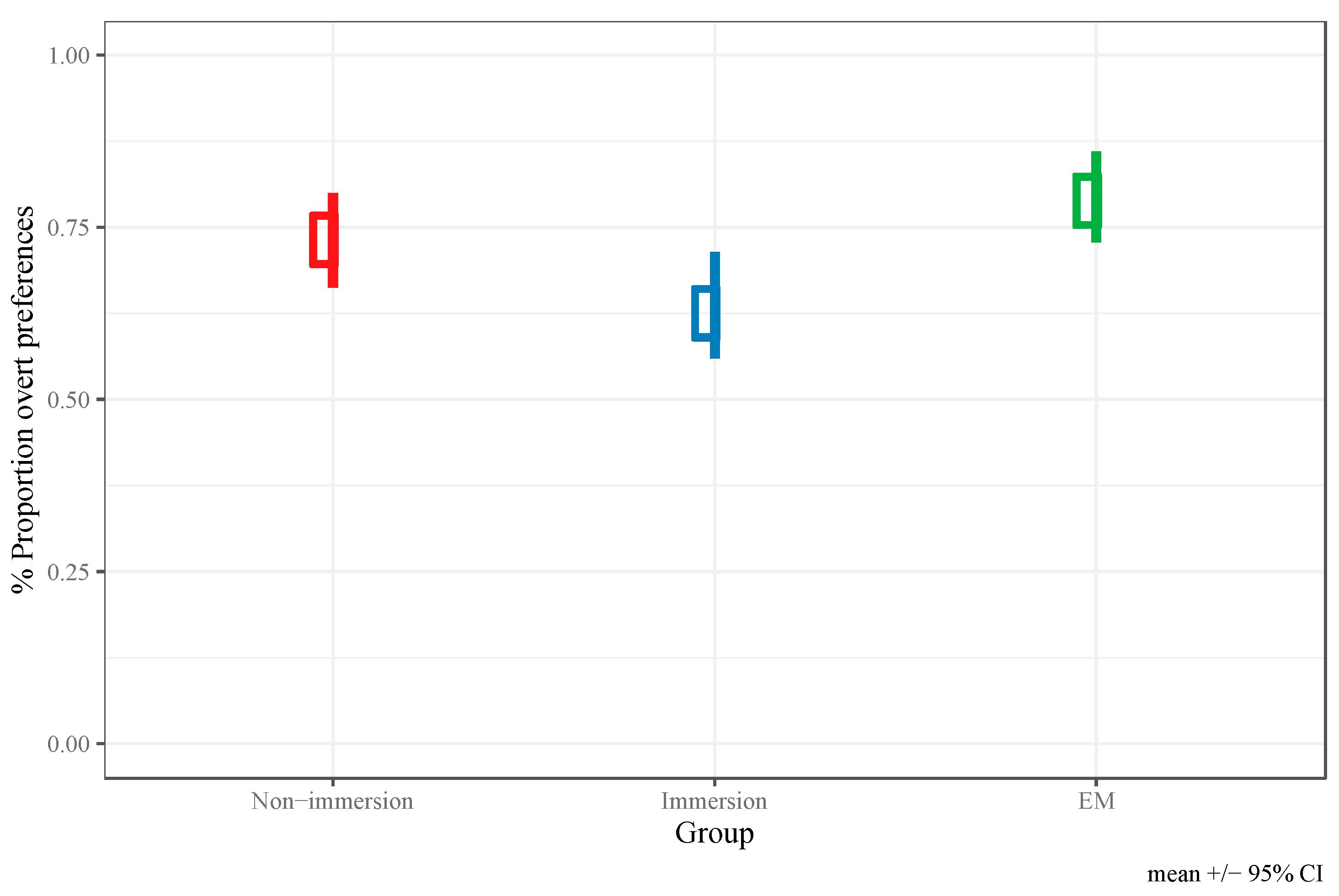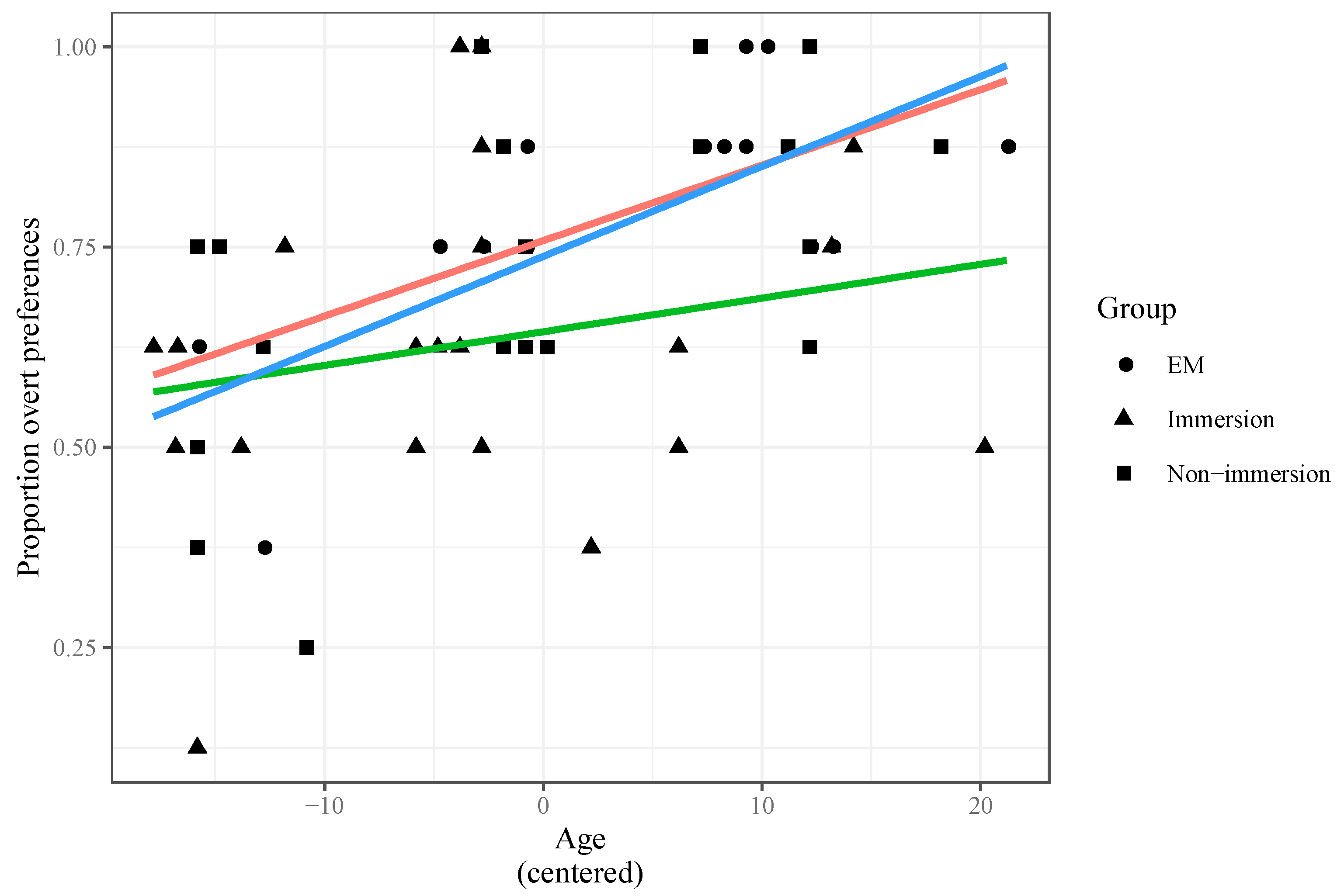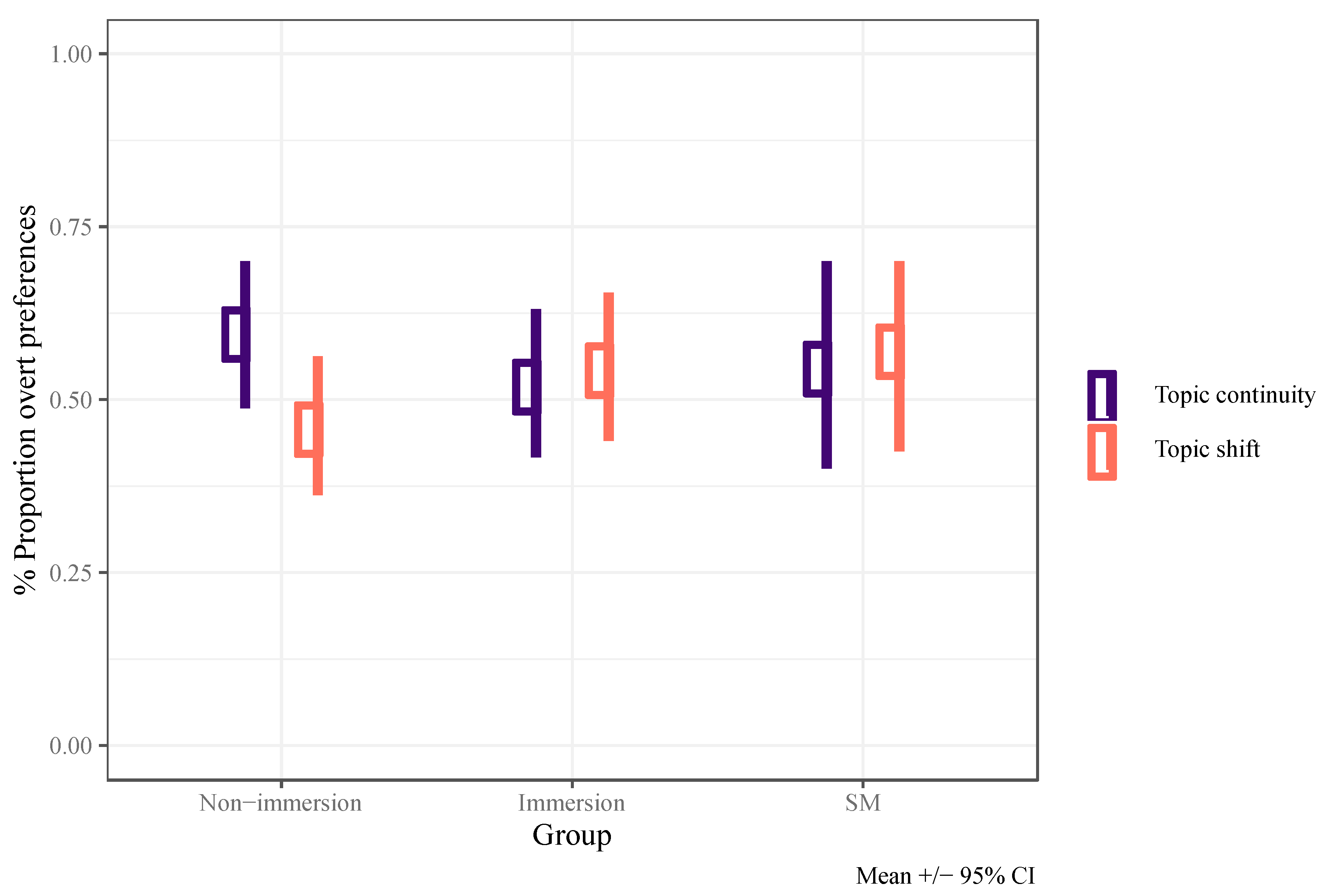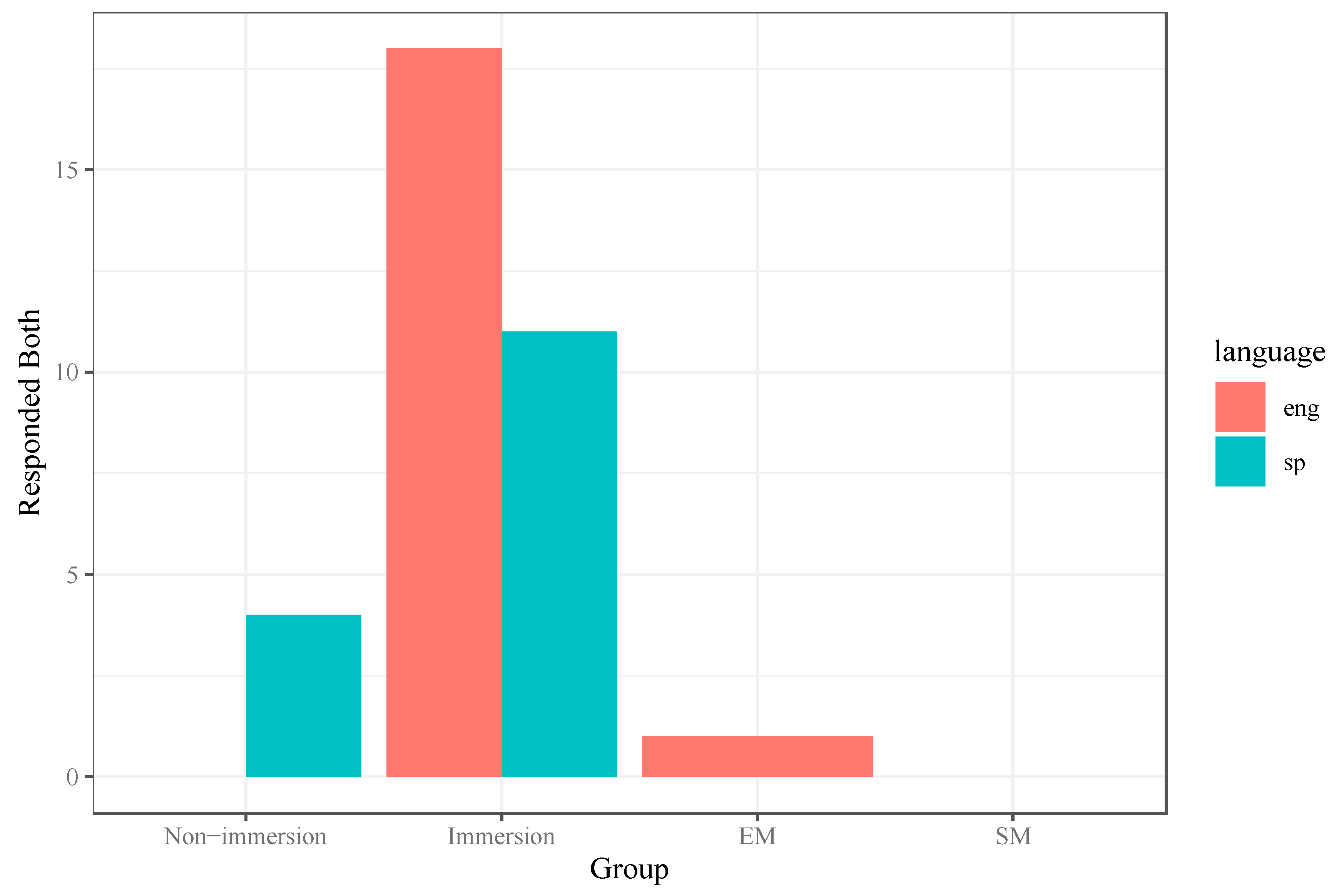An Exploratory Study of the Effect of Spanish Immersion Education on the Acquisition of Pronominal Subjects in Child Heritage Speakers
Abstract
1. Introduction
2. Null Subjects
2.1. Pronominal Subject Realization
- 1.
- (a) Teresa told us that she went to a party.(b) Teresa told us that went to a party.
- 2.
- (a) Teresa llegó al aeropuerto tarde. (pro) Estaba cansada‘Teresa arrived at the airport late. She was tired’.(b) Teresa y Juan llegaron al aeropuerto tarde. Ella estaba cansada.‘Teresa and Juan arrived at the airport late. She was tired’.
2.2. Syntax–Pragmatics Interface
3. Early Acquisition of Subject Pronouns
3.1. Early Pronoun Acquisition in Monolingual Children
3.2. Early Pronoun Acquisition in Bilingual Children
4. Input: Quality and Quantity
5. The Present Study
5.1. Research Questions
5.2. Participants
5.3. Materials and Procedure
- (a)
- −topic shift condition (−TS)Mickey criesMickey: ‘¡He llorado!’‘I have cried!’Minnie: Mickey dijo que ha llorado.‘Mickey said that (he) has cried’.Donald: #Mickey dijo que él ha llorado.#‘Mickey said that he has cried’.
- (b)
- +topic shift condition (+TS)Mickey eatsGoofy: ‘¡Mickey ha comido!’‘Mickey has eaten!’Minnie: #Goofy dijo que ha comido.#‘Goofy said that (he) has eaten’.Donald: Goofy dijo que él ha comido.‘Goofy said that he has eaten’.
- (c)
- −topic shift condition (−TS)Mickey jumpsMickey: ‘I jumped!’Minnie: *Mickey said that jumped.Donald: Mickey said that he jumped.
- (d)
- +topic shift condition (+TS)Goofy coughs.Mickey: ‘Goofy coughed!’Minnie: Mickey said that he coughed.Donald: *Mickey said that coughed.
6. Results
6.1. Pronominal Preferences in English
6.2. Pronominal Preferences in Spanish
6.3. Comparison of Spanish and English
7. Discussion
Limitations
8. Conclusions
Funding
Acknowledgments
Conflicts of Interest
Appendix A
- Mickey criesMickey: ‘¡He llorado!’‘I have cried!’Minnie: Mickey dijo que ha llorado.‘Mickey said that (he) has cried’.Donald: Mickey dijo que él ha llorado.‘Mickey said that he has cried’.
- Mickey laughs.Mickey: ‘¡He reído!’‘I have laughed!’Minnie: Mickey dijo que él ha reído.‘Mickey said that he has laughed’.Donald: Mickey dijo que ha reído.‘Mickey said that (he) has laughed’.
- Goofy falls.Goofy: ‘¡Me he caído!’‘I have fallen!’Minnie: Goofy dijo que se ha caído.‘Goofy said that (he) has fallen’.Donald: Goofy dijo que él se ha caído.‘Goofy said that he has fallen’.
- Goofy jumps.Goofy: ‘¡He saltado!’‘I have jumped!’Minnie: Goofy dijo que ha saltado.‘Goofy said that (he) has jumped’.Donald: Goofy dijo que él ha saltado.‘Goofy said that he has jumped’.
- Mickey eatsGoofy: ‘¡Mickey ha comido!’‘Mickey has eaten!’Minnie: Goofy dijo que ha comido.‘Goofy said that (he) has eaten’.Donald: Goofy dijo que él ha comido.‘Goofy said that he has eaten’.
- Goofy coughsMickey: ‘¡Goofy ha tosido!’‘Goofy has coughed!’Minnie: Mickey dijo que él ha tosido.‘Mickey said that he has coughed’.Donald: Mickey dijo que ha tosido.‘Mickey said that (he) has coughed’.
- Goofy singsMickey: ‘¡Goofy ha cantado!’‘Goofy has sung!’Minnie: Mickey dijo que ha cantado.‘Mickey said that (he) has sung’.Donald: Mickey dijo que él ha cantado.‘Mickey said that he has sung’.
- Mickey sneezes.Goofy: ‘¡Mickey ha estornudado!’‘Mickey has sneezed!’Minnie: Goofy dijo que él ha estornudado.‘Goofy said that he has sneezed’.Donald: Goofy dijo que ha estornudado.‘Goofy said that (he) has sneezed’.
- Goofy: ¡Que flores más lindas hay aquí!What pretty flowers are here!Minnie: Goofy dijo que flores más lindas.Goofy said what pretty flowers.Donald: Goofy dijo que flores más feas.Goofy said what ugly flowers.
- Goofy: ¡Aquí hace mucho calor!It’s hot here!Minnie: Goofy dijo que hace mucho frío.Goofy said that it’s very cold.Donald: Goofy dijo que hace mucho calor.Goofy said that it’s very hot.
- Mickey: ¡My color favorito es el azul!My favorite color is blue!Minnie: Mickey dijo que su color favorito es el azul.Mickey said that his favorite color is blue.Donald: Mickey dijo que su color favorito es el rojo.Mickey said that his favorite color is red.
- Mickey: ¡Cómo me gusta comer pastel!How I love eating cake!Minnie: Mickey dijo que le gusta comer broccoli.Mickey said that he likes eating broccoli.Donald: Mickey dijo que le gusta comer pastel.Mickey said that he likes eating cake.
- Mickey jumpsMickey: ‘I jumped!’Minnie: Mickey said that jumped.Donald: Mickey said that he jumped.
- Mickey laughs.Mickey: ‘I laughed!’Minnie: Mickey said that laughed.Donald: Mickey said that he laughed.
- Goofy falls.Goofy: ‘I fell!’Minnie: Goofy said that he fell.Donald: Goofy said that fell.
- Goofy cries.Goofy: ‘I cried!’Minnie: Goofy said that he cried.Donald: Goofy said that cried.
- Goofy coughs.Mickey: ‘Goofy coughed!’Minnie: Mickey said that he coughed.Donald: Mickey said that coughed.
- Goofy sings.Mickey: ‘Goofy sang!’Minnie: Mickey said that sang.Donald: Mickey said that he sang.
- Mickey sneezes.Goofy: ‘Mickey sneezed!’Minnie: Goofy said that he sneezed.Donald: Goofy said that sneezed.
- Mickey eatsGoofy: ‘Mickey ate!’Minnie: Goofy said that ate.Donald: Goofy said that he ate.
- 5.
- Goofy: There are such pretty flowers here!Minnie: Goofy said there are pretty flowers here.Donald: Goofy said there are ugly flowers here.
- 6.
- Goofy: It’s hot here!Minnie: Goofy said that it’s cold here.Donald: Goofy said that it’s hot here.
- 7.
- Mickey: My favorite color is blue!Minnie: Mickey said that his favorite color is blue.Donald: Mickey said that his favorite color is red.
- 8.
- Mickey: I love eating cake!Minnie: Mickey said that he loves eating broccoli.Donald: Mickey said that he loves eating cake.
References
- Alexiadou, Artemis, and Elena Anagnostopoulou. 1998. Parametrizing AGR: Word order, V-movement and EPP-checking. Natural Language & Linguistic Theory 16: 491–539. [Google Scholar]
- Argyri, Efrosyni, and Antonella Sorace. 2007. Crosslinguistic influence and language dominance in older bilingual children. Bilingualism: Language & Cognition 10: 79. [Google Scholar]
- Austin, Jennifer, Liliana Sánchez, and Silvia Pérez-Cortes. 2017. Null subjects in the early acquisition of English by child heritage speakers of Spanish. In Romance Languages and Linguistic Theory 11. Edited by Silvia Perpiñán, David Heap, Itziri Moreno-Villamar and Adriana Soto-Corominas. Amsterdam: John Benjamins, pp. 209–27. [Google Scholar]
- Barbosa, Pilar. 2011. Pro-drop and theories of pro in the minimalist program part 1: Consistent null subject languages and the pronominal-agr hypothesis. Language & Linguistics Compass 5: 551–70. [Google Scholar]
- Bloom, Paul. 1990. Subjectless sentences in child language. Linguistic Inquiry 21: 491–504. [Google Scholar]
- Cairns, Helen, Gloria Schlisselberg, Dava Waltzman, and Dana McDaniel. 2006. Development of metalinguistic skill: Judging the grammaticality of sentences. Communication Disorders Quarterly 27: 213–20. [Google Scholar] [CrossRef]
- Camacho, José. 2008. Syntactic Variation: The Case of Spanish and Portuguese Subjects. Studies in Hispanic and Lusophone Linguistics 1: 415–33. [Google Scholar] [CrossRef]
- Camacho, José. 2013. Null Subjects. Cambridge: Cambridge University Press. [Google Scholar]
- Chomsky, Noam. 1981. Lectures on Government and Binding. Dordrecht: Foris. [Google Scholar]
- Flores-Ferrán, Nydia. 2007. A Bend in the Road: Subject Personal Pronoun Expression in Spanish after 30 Years of Sociolinguistic Research. Language and Linguistics Compass 1–6: 624–52. [Google Scholar] [CrossRef]
- Frascarelli, Mara. 2007. Subjects, Topics and the Interpretation of Referential Pro: An Interface Approach to the Linking of (Null) Pronouns. Natural Language & Linguistic Theory 4: 691. [Google Scholar]
- Gathercole, Virginia. 2016. Factors Moderating Proficiency in Bilingual Speakers. In Bilingualism across the Lifespan: Factors Moderating Language Proficiency. Edited by E. Nicoladis and S. Montanari. Berlin: Mouton de Gruyter. [Google Scholar]
- Genesee, Fred, Elena Nicoladis, and Johanne Paradis. 1995. Language differentiation in early bilingual development. Journal of Child Language 22: 611–31. [Google Scholar] [CrossRef]
- Grinstead, John. 2000. Case, inflection and subject licensing in child Catalan and Spanish. Journal of Child Language 27: 119–55. [Google Scholar] [CrossRef]
- Grinstead, John. 2004. Subjects and interface delay in child Spanish and Catalan. Language 80: 40–72. [Google Scholar] [CrossRef]
- Grinstead, John, Juliana De la Mora, Mariana Vega-Mendoza, and Blanca Flores. 2009. An Elicited Production Test of the Optional Infinitive Stage in Child Spanish. In Proceedings of the 3rd Conference on Generative Approaches to Language Acquisition North America (GALANA 2008). Edited by Jean Crawford, Koichi Otaki and Masahiko Takahashi. Somerville: Cascadilla Proceedings Project, pp. 36–45. [Google Scholar]
- Grosjean, François. 1998. Studying bilinguals: Methodological and conceptual issues. Bilingualism: Language and Cognition 1: 131–49. [Google Scholar] [CrossRef]
- Hacohen, Aviya, and Jeannette Schaeffer. 2007. Subject Realization in Early Hebrew/English Bilingual Acquisition: The Role of Crosslinguistic Influence. Bilingualism: Language and Cognition 10: 333–44. [Google Scholar] [CrossRef]
- Haznedar, Belma. 2010. Transfer at the syntax–pragmatics interface: Pronominal subjects in bilingual Turkish. Second Language Research 26: 355–78. [Google Scholar] [CrossRef]
- Hochberg, Judith. 1986. Functional compensation for /-s/ deletion in Puerto Rican Spanish. Language 62: 609–21. [Google Scholar] [CrossRef]
- Hulk, Aafke, and Nastascha Müller. 2000. Bilingual first language acquisition at the interface between syntax and pragmatics. Bilingualism: Language and Cognition 3: 227–44. [Google Scholar] [CrossRef]
- Hyams, Nina. 1986. Language Acquisition and the Theory of Parameters. Dordrecht: Reidel. [Google Scholar]
- Hyams, Nina. 2011. Missing Subjects in Early Child Language. In Handbook of Generative Approaches to Language Acquisition. Edited by Jill de Villiers and Thomas Roeper. Dordrecht: Springer, pp. 13–52. [Google Scholar]
- Hyams, Nina, and Osvaldo Jaeggli. 1988. Morphological uniformity and the setting of the null subject parameter. Northeastern Linguistic Society 18: 238–52. [Google Scholar]
- Hyams, Nina, and Kenneth Wexler. 1993. The grammatical basis of null subjects in child language. Linguistic Inquiry 24: 421–59. [Google Scholar]
- Hyams, Nina, Victoria Mateu, Robyn Orfitelli, Michael Putnam, Jason Rothman, and Liliana Sánchez. 2014. Parameter Theory in Language Acquisition and Change: An Overview. In Contemporary Linguistic Parameters. Edited by Antonio Fábregas, Jaume Mateu and Michael Putnam. London: Bloomsbury. [Google Scholar]
- Kupisch, Tanja, and Cristina Pierantozzi. 2010. Interpreting definite plural subjects: A comparison of German and Italian monolingual and bilingual children. In Proceedings of the 34th BUCLD. Edited by K. Franich, K. M. Iserman and L. L. Keil. Boston: Cascadilla Press, pp. 245–54. [Google Scholar]
- Kupisch, Tanja, and Jason Rothman. 2016. Terminology matters! Why difference is not incompleteness and how early child bilinguals are heritage speakers. International Journal of Bilingualism 22. [Google Scholar] [CrossRef]
- Lardiere, Donna. 2008. Feature-assembly in second language acquisition. In The Role of Features in Second Language Acquisition. Edited by Juana Liceras, Helmut Zobl and Helen Goodluck. Mahway: Lawrence Erlbaum Associates, pp. 106–40. [Google Scholar]
- Liceras, Juana, Raquel Fernández Fuertes, and Anahí Alba de la Fuente. 2012. Overt subjects and copula omission in the Spanish and the English grammar of English–Spanish bilinguals: On the locus and directionality of interlinguistic influence. First Language 32: 88–115. [Google Scholar] [CrossRef]
- Lubbers, Margaret Quesada, and Sarah Blackwell. 2009. The L2 Acquisition of null and overt Spanish subject pronouns: A pragmatic approach. In Selected Proceedings of the 11th Hispanic Linguistics Symposium. Edited by Joseph Collentine, Maryellen García, Barbara Lafford and Francisco Marcos Marín. Somerville: Cascadilla Proceedings Project, pp. 117–30. [Google Scholar]
- Meisel, Jürgen M. 1989. Early differentiation of languages in bilingual children. In Bilingualism across the Life Span: Aspects of Acquisition, Maturity, and Loss. Edited by Kenneth Hyltenstam and Lorraine Obler. Cambridge: Cambridge University Press, pp. 13–40. [Google Scholar]
- Montalbetti, Mario. 1984. After Binding. Ph.D. dissertation, MIT, Cambridge, MA, USA. [Google Scholar]
- Montrol, Silvina, and Kim Potowski. 2007. Command of gender agreement in school-age Spanish-English Bilingual Children. International Journal of Bilingualism 11: 301–28. [Google Scholar] [CrossRef]
- Montrul, Silvina. 2004a. Subject and object expression in Spanish heritage speakers: A case of morphosyntactic convergence. Bilingualism: Language and Cognition 7: 125–42. [Google Scholar] [CrossRef]
- Montrul, Silvina. 2004b. The Acquisition of Spanish: Morphosyntactic Development in Monolingual and Bilingual L1 Acquisition and Adult L2 Acquisition. Amsterdam: Benjamins. [Google Scholar]
- Montrul, Silvina. 2016. The Acquisition of Heritage Languages. Cambridge: Cambridge University Press. [Google Scholar]
- Müller, Natascha, and Aafke Hulk. 2001. Crosslinguistic Influence in bilingual acquisition: Italian and French as recipient languages. Bilingualism: Language and Cognition 4: 1–21. [Google Scholar] [CrossRef]
- Orfitelli, Robyn, and Nina Hyams. 2008. An experimental study of children’s comprehension of null subjects: Implications for grammatical/performance accounts. In BUCLD 32 Proceedings. Edited by Harvey Chan, Heather Jacob and Enkeleida Kapia. Somerville: Cascadilla Press, pp. 335–46. [Google Scholar]
- Orfitelli, Robyn, and Nina Hyams. 2012. Children’s Grammar of Null Subjects: Evidence from Comprehension. Linguistic Inquiry 43: 563–590. [Google Scholar]
- Paradis, Johanne. 2011. The impact of input factors on bilingual development. Linguistic Approaches to Bilingualism 1: 67–70. [Google Scholar] [CrossRef]
- Paradis, Johanne, and Samuel Navarro. 2003. Subject realization and crosslinguistic interference in the bilingual acquisition of Spanish and English: What is the role of input? Journal of Child Language 30: 371–93. [Google Scholar] [CrossRef]
- Peña, Elizabeth, Vera Gutierrez-Clellen, Aquiles Iglesias, Brian Goldstein, and Lisa Bedore. 2014. Bilingual English Spanish Assessment (BESA). San Rafael: AR Clinical Publications. [Google Scholar]
- Pires, Acrisio, and Jason Rothman. 2009. Disentangling sources of incomplete acquisition: An explanation for competence divergence across heritage grammars. International Journal of Bilingualism 13: 211–38. [Google Scholar] [CrossRef]
- Polinsky, Maria. 2007. Heritage languages: In the “wild” and in the classroom. Language and Linguistics Compass 1: 368–95. [Google Scholar] [CrossRef]
- Potowski, Kim. 2007. Characteristics of the Spanish grammar and sociolinguistic proficiency of dual immersion graduates. Spanish in Context 4: 187–216. [Google Scholar] [CrossRef]
- Putnam, Michael, and Liliana Sánchez. 2013. What’s so incomplete about incomplete acquisition?—A prolegomenon to modeling heritage language grammars. Linguistic Approaches to Bilingualism 3: 378–504. [Google Scholar] [CrossRef]
- R Development Core Team. 2012. R: A Language and Environment for Statistical Computing. Available online: http://www.R-project.org (accessed on 1 January 2017).
- RAE, and ASALE. 2009. Nueva Gramática de la Lengua Española. Morfología y Sintaxis. Madrid: Espasa. [Google Scholar]
- Rizzi, Luigi. 1986. Null objects in Italian and the theory of pro. Linguistic Inquiry 17: 501–58. [Google Scholar]
- Rizzi, Luigi. 2005. On the Grammatical Basis of Language Development: A Case Study. In The Oxford Handbook of Comparative Syntax. Edited by Guglielmo Cinque and Richard S. Kayne. New York: Oxford University Press, pp. 70–109. [Google Scholar]
- Roeper, Thomas. 1999. Universal bilingualism. Bilingualism, Language and Cognition 2: 169–86. [Google Scholar] [CrossRef]
- Rothman, Jason. 2009. Pragmatic deficits with syntactic consequences? L2 pronominal subjects and the syntax–pragmatics interface. Journal of Pragmatics 41: 951–73. [Google Scholar] [CrossRef]
- Serafini, Ellen, Nadine Rozell, and Adam Winsler. 2020. Academic and English language outcomes for DLLs as a function of school bilingual education model: The role of two-way immersion and home language support. International Journal of Bilingual Education and Bilingualism. [Google Scholar] [CrossRef]
- Serratrice, Ludovica. 2005. The role of discourse pragmatics in the acquisition of subjects in Italian. Applied Psycholinguistics 26: 437–62. [Google Scholar] [CrossRef]
- Serratrice, Ludovica. 2006. Referential cohesion in the narratives of bilingual English-Italian children and monolingual peers. Journal of Pragmatics 39: 1058–87. [Google Scholar] [CrossRef]
- Serratrice, Ludovica. 2007. Cross-Linguistic Influence in the Interpretation of Anaphoric and Cataphoric Pronouns in English-Italian Bilingual Children. Bilingualism: Language and Cognition 10: 225–38. [Google Scholar] [CrossRef]
- Shin, Naomi, and Helen Cairns. 2012. The development of NP selection in school-age children: Reference and Spanish subject pronouns. Language Acquisition 19: 3–38. [Google Scholar] [CrossRef]
- Sorace, Antonella. 2004. Native language attrition and developmental instability at the syntax-discourse interface: Data, interpretations and Methods. Bilingualism: Language and Cognition 7: 143–45. [Google Scholar] [CrossRef]
- Sorace, Antonella, and Francesca Filiaci. 2006. Anaphora resolution in near-native speakers of Italian. Second Language Research 22: 339–68. [Google Scholar] [CrossRef]
- Sorace, Antonella, and Ludovica Serratrice. 2009. Internal and external interfaces in bilingual language development: Beyond structural overlap. International Journal of Bilingualism 13: 195–210. [Google Scholar] [CrossRef]
- Sorace, Antonella, Ludovica Serratrice, Francesca Filiaci, and Michela Baldo. 2009. Discourse conditions on subject pronoun realization: Testing the linguistic intuitions of older bilingual children. Lingua 119: 460–77. [Google Scholar] [CrossRef]
- Valdés, Guadalupe. 2000. Spanish for Native Speakers: AATSP Professional Development Series Handbook for Teachers K-16. New York: Harcourt College, vol. 1. [Google Scholar]
- Valian, Virginia. 1991. Syntactic subjects in the early speech of American and Italian children. Cognition 40: 21–81. [Google Scholar] [CrossRef]
- Yager, Lisa, Nora Hellmold, Hyoun-A. Joo, Michael T. Putnam, Eleonora Rossi, Catherine Stafford, and Jospeh Salmons. 2015. New Structural Patterns in Moribund Grammar: Case Marking in Heritage German. Frontiers in Psychology 6: 1716. [Google Scholar] [CrossRef] [PubMed]
| 1 | Other researchers have identified more detailed constraints. For instance, the overt pronoun constraint (OPC) (Montalbetti 1984) provides an account for the distribution of null and overt pronouns in subject position in null-subject languages. Additionally, (Lubbers and Blackwell 2009) outline a series of pragmatic rules associated with both null and overt subject pronouns in Spanish including salient referents, epistemic parentheticals, switch focus, contrastive focus, and pragmatic weight. For a review of other constraints, see (Flores-Ferrán 2007). |
| 2 | As an alternative, (Rizzi 2005) proposed yet another parameter model, different to the parameters referred to by (Hyams 1986, 2011), to account for the null subject stage called the root null subject parameter (RNS). The RNS parameter specifies that, in overt-subject languages, a subject may be null in the specifier of the root. According to (Hyams et al. 2014, p. 355), the RNS “assumes children’s grammars set an initial null-subject setting under pressure from a computational strategy favoring parametric values that reduce the load on the production system (null subjects are computationally less costly than overt subjects, by hypothesis).” |
| 3 | Other than Caribbean Spanish (Hochberg 1986; Camacho 2008), no significant differences have been shown to exist between varieties of Spanish in terms of the discourse pragmatic constraints that guide null and overt subject use for a review, see (Flores-Ferrán 2007). Therefore, the Spanish speakers from Spain seemed a suitable comparison group. |
| 4 | There were no trial items. To account for this, no item effects were found during the statistical analysis and accuracy on the filler items (which tested true/false understanding) was high in both languages as noted in Section 6. |
| 5 | The inclusion of only four filler items was made so that the task would not become too long for the children who were quite young. For this same reason, subject position was not tested or included as a variable in the experimental items. This would have increased the number of items and extended the study time for the children. |
| 6 | In Spanish, intonation and stress were not accounted for in the recordings, which was brought to the attention of the researcher later on. Emphasis on the overt pronoun could have led to a bias of over-acceptance of the overt subjects, but this was not the case as will be discussed further in Section 6 and Section 7. Therefore, intonation and stress did not seem to bias the results. |




| Spanish Exposure | Immersion (n = 21) | Non-Immersion (n = 20) | EM (n = 17) | SM (n = 18) |
|---|---|---|---|---|
| School | 100% | 0% | 0% | 100% |
| One parent only | 71% | 55% | 0% | 0% |
| Both parents | 29% | 45% | 0% | 100% |
| Grandparents/family | 90% | 93% | 0% | 100% |
| TV, books, games, music | 80% | 100% | 0% | 100% |
| Visits to Spanish language countries | 24% | 80% | 0% | N/A |
| Spanish maintenance is important/a priority | 100% | 100% | N/A | N/A |
| English with parents | 46% | 46% | 100% | 10% |
| English with siblings | 93% | 93% | 100% | 0% |
| English exposure since birth | 100% | 95% | 100% | 10% |
| Group | Spanish Mean | Spanish SD | English Mean | English SD |
|---|---|---|---|---|
| Immersion | 77.05 | 11.79 | 89.05 | 13.79 |
| Non-Immersion | 75.90 | 14.19 | 85.50 | 14.67 |
| EM | N/A | N/A | 97.06 | 5.72 |
| SM | 91.80 | 7.60 | N/A | N/A |
| Group | β | SE | z-Value | p |
|---|---|---|---|---|
| Intercept | 0.47 | 0.18 | 2.63 | <0.009 |
| Non-Immersion | 0.83 | 0.33 | 2.53 | <0.02 |
| EM | 1.02 | 0.33 | 3.27 | <0.002 |
| Age | 0.06 | 0.02 | 2.68 | <0.007 |
| Group non-immersion: age | 0.00 | 0.03 | 0.17 | =0.86 |
| Group immersion: age | −0.04 | 0.03 | −1.49 | =0.13 |
| Group | β | SE | z-Value | p |
|---|---|---|---|---|
| Intercept | 0.16 | 0.21 | 0.79 | =0.43 |
| Non-Immersion | −0.04 | 0.23 | −0.19 | =0.85 |
| SM | 0.85 | 0.28 | 0.31 | =0.76 |
| Age | 0.01 | 0.01 | 0.96 | =0.34 |
| Group | Language | Pronoun Type | Mean Response |
|---|---|---|---|
| Non-immersion | English | overt | 0.74 |
| Spanish | null | 0.60 | |
| Spanish | overt | 0.46 | |
| Immersion | English | overt | 0.63 |
| Spanish | null | 0.52 | |
| Spanish | overt | 0.55 | |
| EM | English | overt | 0.79 |
| SM | Spanish | null | 0.55 |
| Spanish | overt | 0.56 |
© 2020 by the author. Licensee MDPI, Basel, Switzerland. This article is an open access article distributed under the terms and conditions of the Creative Commons Attribution (CC BY) license (http://creativecommons.org/licenses/by/4.0/).
Share and Cite
Goldin, M. An Exploratory Study of the Effect of Spanish Immersion Education on the Acquisition of Pronominal Subjects in Child Heritage Speakers. Languages 2020, 5, 18. https://doi.org/10.3390/languages5020018
Goldin M. An Exploratory Study of the Effect of Spanish Immersion Education on the Acquisition of Pronominal Subjects in Child Heritage Speakers. Languages. 2020; 5(2):18. https://doi.org/10.3390/languages5020018
Chicago/Turabian StyleGoldin, Michele. 2020. "An Exploratory Study of the Effect of Spanish Immersion Education on the Acquisition of Pronominal Subjects in Child Heritage Speakers" Languages 5, no. 2: 18. https://doi.org/10.3390/languages5020018
APA StyleGoldin, M. (2020). An Exploratory Study of the Effect of Spanish Immersion Education on the Acquisition of Pronominal Subjects in Child Heritage Speakers. Languages, 5(2), 18. https://doi.org/10.3390/languages5020018





